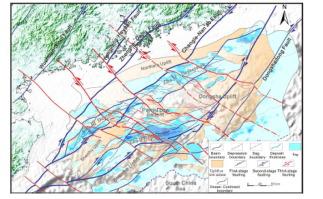Gondwana Research ( IF 7.2 ) Pub Date : 2022-06-21 , DOI: 10.1016/j.gr.2022.05.023 Pengcheng Wang , Yanhui Suo , Guangrong Peng , Sanzhong Li , Xiaodong Du , Xianzhi Cao , Jie Zhou , Guangzeng Wang , M. Santosh , Suhua Jiang , Ze Liu , Junjiang Zhu

|
In the Cenozoic, the East Asian Continental Margin developed intense rifting, producing massive rift basins and marginal seas. Among these, the South China Sea (SCS) and adjacent continental margin have attracted attention due to the obscure opening mechanism and strong lithospheric thinning. Based on the seismic sections and fault architecture data in this paper, we perform a delicate study of fault geometry, kinematics, and dynamics in the Pearl River Mouth Basin (PRMB). Three-stage Cenozoic extension is identified in the PRMB. The earliest NNW-SSE-directed extension occurred as early as the Paleocene, resulting in the NE- and ENE-trending faulting with dextral oblique extension to continue until the Middle Eocene. The second extension in the N-S direction resulted in NE-trending dextral transtension in the Late Eocene to Early Oligocene (∼40-30 Ma). Subsequently, the latest extension with the NNW-SSE direction occurred during the Late Oligocene, resulting in the sinistral strike-slip of a large number of WNW-trending faults. This second-third extension produced a NE-striking transtensional fault system with dextral right-stepping characteristics. In the Oligocene, this fault system resulted in the scissor-type opening of the SCS with a progressively westward younging oceanic crust. During the Early Miocene, the dextral transtensional fault system disappeared due to the Pacific Plate subduction eastward retreat and the cease of the RRF sinistral strike-slipping. At this time, the SCS ridge spreading was controlled only by the NW-SE-oriented slab-pull linked to the proto-SCS.
中文翻译:

新生代珠江口盆地三期伸展引发南海扩张开始
新生代,东亚大陆边缘发育强烈裂谷,产生大量裂谷盆地和边缘海。其中,南海(SCS)及邻近大陆边缘因开放机制不明、岩石圈强烈减薄而备受关注。基于本文中的地震剖面和断层结构数据,我们对珠江口盆地(PRMB)的断层几何、运动学和动力学进行了细致的研究。在 PRMB 中确定了三阶段新生代扩展。最早的 NNW-SSE 方向的伸展早在古新世,导致 NE 向和 ENE 向的断裂带右旋倾斜伸展一直持续到中始新世。NS 方向的第二次延伸导致晚始新世到早渐新世(~40-30 Ma)的 NE 趋势右旋体过渡。随后,在晚渐新世发生了最近一次NNW-SSE方向的伸展,导致大量WNW向断层左旋走滑。这个第二第三延伸产生了具有右旋右步特征的NE走向的跨张断层系统。在渐新世,这一断层系统导致南海剪刀式张开,洋壳逐渐向西年轻化。早中新世,由于太平洋板块俯冲东撤和RRF左旋走滑停止,右旋伸展断裂系统消失。此时,











































 京公网安备 11010802027423号
京公网安备 11010802027423号